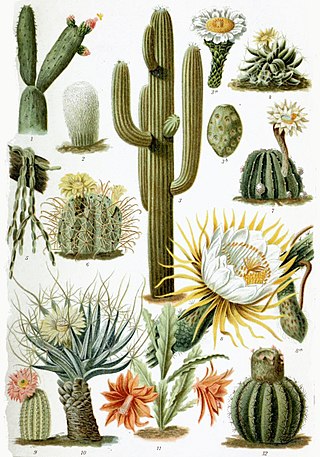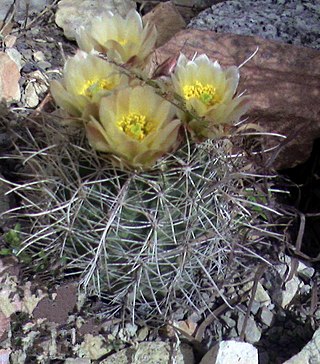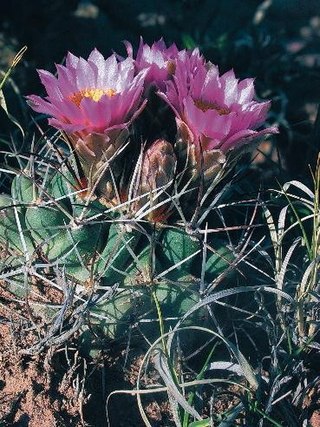
A cactus is a member of the plant family Cactaceae, a family comprising about 127 genera with some 1,750 known species of the order Caryophyllales. The word cactus derives, through Latin, from the Ancient Greek word κάκτος (káktos), a name originally used by Theophrastus for a spiny plant whose identity is now not certain. Cacti occur in a wide range of shapes and sizes. They are native to the Americas, ranging from Patagonia in the south to parts of western Canada in the north, with the exception of Rhipsalis baccifera, which is also found in Africa and Sri Lanka. Cacti are adapted to live in very dry environments, including the Atacama Desert, one of the driest places on Earth. Because of this, cacti show many adaptations to conserve water. For example, almost all cacti are succulents, meaning they have thickened, fleshy parts adapted to store water. Unlike many other succulents, the stem is the only part of most cacti where this vital process takes place. Most species of cacti have lost true leaves, retaining only spines, which are highly modified leaves. As well as defending against herbivores, spines help prevent water loss by reducing air flow close to the cactus and providing some shade. In the absence of true leaves, cacti's enlarged stems carry out photosynthesis.

Ferocactus is a genus of large barrel-shaped cacti, mostly with large spines and small flowers. There are about 30 species included in the genus. They are found in the southwestern United States and northwestern Mexico.

Cleistocactus strausii, the silver torch or wooly torch, is a perennial flowering plant in the family Cactaceae. It is native to mountainous regions of Department Tarija, Bolivia, at 1,500–3,000 m (4,921–9,843 ft).

Bergerocactus emoryi is a species of cactus, known commonly as the golden-spined cereus, golden snake cactus, velvet cactus or golden club cactus. It is a relatively small cactus, but it can form dense thickets or colonies, with the dense yellow spines giving off a velvety appearance when backlit by the sun. From April to May, yellow, green-tinged flowers emerge, which transform into reddish, globular fruit. This species is native to the California Floristic Province, and is found in northwestern Baja California and a small part of California, in San Diego County and on the southern Channel Islands. Where the Mediterranean climate of the California Floristic Province collides with the subtropical Sonoran Desert near El Rosario, hybrids with two other species of cacti are found. It is the sole member of the monotypic genus Bergerocactus, named after German botanist Alwin Berger.

Coryphantha, or beehive cactus, is a genus of small to middle-sized, globose or columnar cacti. The genus is native to arid parts of Central America, Mexico, through Arizona, New Mexico, and western Texas and north into southwestern, central, and southeastern Montana. With its two subgenera, 57 species and 20 subspecies, it is one of the largest genera of cactus.

Obregonia, the artichoke cactus, is a monotypic genus of cacti, containing the species Obregonia denegrii. The species is endemic to the state of Tamaulipas in Mexico.

Sclerocactus is a genus of cacti. It comprises about 15 species, the exact number depending on the authority. These species are very xerophytic. They are sometimes called 'fishhook cactus' or 'little barrels.'

Fishhook cactus is a common name for any hook-spined species of the genera Mammillaria, Echinomastus or Sclerocactus. They are small cacti, usually growing up to 6-7 inches (20 cm) high, and are shaped similar to a barrel cactus. They are not to be confused with the fishhook barrel cactus of the Sonoran and Chihuahuan Deserts. The Fishhook cactus is a large category of around 150 species.

Astrophytum asterias is a species of cactus in the genus Astrophytum, and is native to small parts of Texas in the United States and Mexico. Common names include sand dollar cactus, sea urchin cactus, star cactus and star peyote.

Pediocactus bradyi subsp. winkleri, commonly known as Winkler's cactus or Winkler's pincushion cactus, is a small cactus endemic to the state of Utah in the United States. It is known only from Emery and Wayne Counties.

Sclerocactus brevihamatus is a species of cactus known by the common name shorthook fishhook cactus.

Pelecyphora sneedii is a rare species of cactus known by the common names Sneed's pincushion cactus and carpet foxtail cactus.

Echinomastus mariposensis is a rare species of cactus known by the common names Lloyd's fishhook cactus, golfball cactus, silver column cactus, and Mariposa cactus. It is native to a small section of territory straddling the border between Brewster County, Texas, in the United States and the state of Coahuila in Mexico. It has been federally listed as a threatened species in the United States since 1979.

Pediocactus sileri is a rare species of cactus known by the common names Siler's pincushion cactus and gypsum cactus. It is native to southwestern Utah and northwestern Arizona in the United States. It is limited to a specific type of soil, individuals are often spaced far apart, and the species is threatened by a number of human activities such as off-road vehicle use, poaching, and uranium mining. This is a federally listed threatened species of the United States.

Pediocactus bradyi is a very rare species of cactus known by the common names Brady's pincushion cactus, Brady's hedgehog cactus, and Marble Canyon cactus. It is endemic to Arizona in the US, where it is restricted to Marble Canyon in Coconino County, though its exact distribution is not generally advertised due to poaching concerns. It is limited to a specific type of soil, it has a small distribution, and the species is threatened by a number of human activities. This has been a federally listed endangered species of the United States since 1979.

Sclerocactus glaucus is a rare species of cactus known by the common name Colorado hookless cactus. It is endemic to Colorado in the United States, where it is known only from the area between Grand Junction and Montrose. It is a federally listed threatened species.

Sclerocactus wrightiae is a rare species of cactus known by the common names Wright's little barrel cactus and Wright's fishhook cactus.

Opuntia macrocentra, the long-spined purplish prickly pear or purple pricklypear, is a cactus found in the lower Southwestern United States and Northwestern Mexico. A member of the prickly pear genus, this species of Opuntia is most notable as one of a few cacti that produce a purple pigmentation in the stem. Other common names for this plant include black-spined pricklypear, long-spine prickly pear, purple pricklypear, and redeye prickly pear.

Sclerocactus sileri, the Siler fishhook cactus, is a rare and very small cactus found mostly in mineral-rich desert areas of intermediate elevations, notably in the American states of Utah, Nevada, and northern Arizona.

Thelocactus setispinus, commonly known as miniature barrel cactus or hedgehog cactus, is a species of cactus in the family Cactaceae.






















